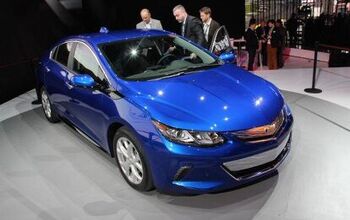GM Market Share In Reverse For Q1
Back in October, GM’s then-CEO Fritz Henderson announced that GM would make a stand on market share, refusing to allow its share of the US market to slip below 29 percent. Oh wait, that was Gary Cowger’s campaign of 2003, which saw GM execs wearing symbolic “29” lapel pins. Where Henderson actually drew GM’s market share line in the sand six months ago was
At this point about 19 percent… We’ll finalize that, but I’m not interested in going down from that
And according to the Detroit Free Press, GM actually achieved that goal in December, logging a 21 percent share based on Autodata findings. Unfortunately, things have been slip-sliding ever since. In February, GM’s share fell to 18.1 percent, and last month it fell even further, to 17.6 percent.
Of course, having Toyota fighting its way out of some bad publicity with unprecedented incentives didn’t help… except that GM’s average incentives were nearly $1,000 higher than Toyota’s. And with GM’s turnaround plan based on an 18.5 percent share of a 12.5m overall market, this share slide would be dangerous enough even without real fears that the market won’t even hit 12m units this year. The fact that this troubling performance has come at the expense of consistently industry-leading incentives does not leave one sanguine about next month’s release of GM’s Q1 financials.
Analysts smell trouble, and apparently feel no need to sugar-coat it. As Barclay’s Capital’s Brian Johnson said of The General’s March performance:
GM’s passenger car performance was materially weaker than we expected
Erich Merkle of Autoconomy never even expected GM’s market share to recover to Fritz’s line-in-the-sand level, saying:
GM for some reason always has these critical market-share milestones that they put in place for themselves, then they blow through them. The real focus for GM has to be being profitable
And sure, GM can (and probably will) cut costs to squeeze as close to a profit as possible, but IPO investors are going to want to see more than just belt-tightening. If GM doesn’t start making headway expanding its business, and do so without increasing incentives past their already-industry-leading levels, there’s not much hope of attracting the kind of investment it needs to pay back the government for its equity stake. On the other hand, GM is going to struggle to win over consumers until it is free of its political entanglements. And with decades of market share decline having gone unchecked by the words, deeds and lapel pins of GM management, it’s clear which way the momentum is heading.
More by Edward Niedermeyer
Latest Car Reviews
Read moreLatest Product Reviews
Read moreRecent Comments
- Brandon I would vote for my 23 Escape ST-Line with the 2.0L turbo and a normal 8 speed transmission instead of CVT. 250 HP, I average 28 MPG and get much higher on trips and get a nice 13" sync4 touchscreen. It leaves these 2 in my dust literally
- JLGOLDEN When this and Hornet were revealed, I expected BOTH to quickly become best-sellers for their brands. They look great, and seem like interesting and fun alternatives in a crowded market. Alas, ambitious pricing is a bridge too far...
- Zerofoo Modifications are funny things. I like the smoked side marker look - however having seen too many cars with butchered wire harnesses, I don't buy cars with ANY modifications. Pro-tip - put the car back to stock before you try and sell it.
- JLGOLDEN I disagree with the author's comment on the current Murano's "annoying CVT". Murano's CVT does not fake shifts like some CVTs attempt, therefore does not cause shift shock or driveline harshness while fumbling between set ratios. Murano's CVT feels genuinely smooth and lets the (great-sounding V6) engine sing and zing along pleasantly.
- JLGOLDEN Our family bought a 2012 Murano AWD new, and enjoyed it for 280K before we sold it last month. CVT began slipping at 230K but it was worth fixing a clean, well-cared for car. As soon as we sold the 2012, I grabbed a new 2024 Murano before the body style and powertrain changes for 2025, and (as rumored) goes to 4-cyl turbo. Sure, the current Murano feels old-school, with interior switchgear and finishes akin to a 2010 Infiniti. That's not a bad thing! Feels solid, V6 sounds awesome, and the whole platform has been around long enough that future parts & service wont be an issue.


































Comments
Join the conversation
Was suprised to find out the new Buick Lacrosse was the heavyist US (sedan) car (includes Cadillac DTS) built.
Well, the autoblog guys seem to have a little different view of this than you do. . . It seems to me that market share is a secondary consideration, and there's no point in continuing to beat the dead horse of the precipitous fall of GM's market share over the years. Certainly, one would expect that closing or selling off brands at least in the short term, is going to reduce total sales volume and, likely, market share. A lost Pontiac or Saturn sale does not translate one-for-one to a Chevy sale. The real question is what is the total sales volume that is required to support GM's present cost structure and return a respectable bottom-line profit, not EBIDTA, but profit? So, if costs are able to be cut faster than revenues fall, we're doing o.k. If not, we're not. If the fall in revenues can be arrested, that's good. If it can be turned around, that's even better. "Market share" is just bragging rights, as the old GM found out and as even Toyota has fairly explicitly acknowledged. What's important is profitability.